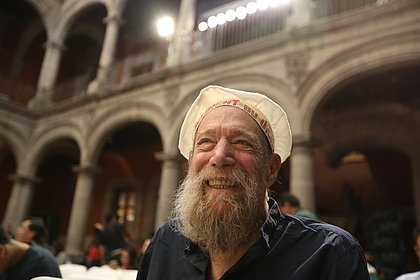United States
Lawrence Weiner


Biography
Lawrence Weiner est né en 1942 dans le Bronx, à New York. En 1968, il expose aux côtés de Carl Andre et de Robert Barry au Windham College, à Putney (Vermont). L’année suivante, il participe à l’exposition mythique Quand les attitudes deviennent forme, organisée par Harald Szeemann à Berne. Une importante rétrospective de son travail est présentée en 2007-2008 au MOCA à Los Angeles et au Whitney Museum of American Art à New York, avant de voyager en Allemagne.
Il participe plusieurs fois à la Documenta de Kassel, ainsi qu'à la Biennale de Venise et à celle de São Paulo en 2006. Ses œuvres sont exposées dans les plus grands musées du monde et in situ dans différentes villes. Il reçoit de nombreux prix dont, en 2015, le prix Roswitha Haftmann à Zurich, l'une des récompenses artistiques les plus prestigieuses du monde. Il vit et travaille à New York.

About the artworks
Après divers petits boulots, Lawrence Weiner parcourt, encore adolescent, les États-Unis, le Mexique et le Canada à la fin des années 1950 et au début des années 1960. Autodidacte, il commence à montrer ses œuvres peu après son retour. Ses premières expositions frappent les esprits, l’artiste y subvertissant radicalement les formes et les structures de l'art traditionnel. Selon Weiner, l’œuvre d’art n’a pas besoin d’exister physiquement ; le public est lui aussi capable de concevoir ou d’élaborer. En 1969, il participe à l’exposition fondatrice d’Harald Szeemann Quand les attitudes deviennent forme aux côtés d’autres artistes émergents, devenus entre-temps des figures tutélaires pour les générations ultérieures. Il énonce alors sa position vis-à-vis de l'art, selon laquelle : « 1. L'artiste peut construire le travail, 2. Le travail peut être fabriqué, 3. Le travail peut ne pas être réalisé. Chacune de ces possibilités étant égale et coïncidant avec la volonté de l'artiste. Le choix de l'une ou de l'autre de ces situations incombe au récepteur au moment de la réception ». Ces théories marqueront durablement le paysage artistique.
Pilier du mouvement de l’art conceptuel, Lawrence Weiner est un prodigieux explorateur du pouvoir des mots. Immédiatement lisibles et reconnaissables, ceux-ci sont devenus l'un des aspects majeurs de son travail, rappelant les inscriptions murales du quartier new-yorkais de son enfance. C'est à partir de 1970 que les mots deviennent un moyen d’expression privilégié de l’artiste, dans tous les médiums et tous les formats, notamment dans des livres, des vidéos, sur les murs de bâtiments ou dans les rues des villes.
S’inscrivant de manière impressionnante dans l’espace, les inscriptions de Weiner agissent avec une puissance comparable à la sculpture. Weiner croit en effet à la capacité des mots d’exercer un réel impact sur le spectateur pour peu que celui-ci soit disponible et réceptif, et à servir de base à la construction d’une image ou d’un effet. Le choix et la taille de la typographie, l’articulation des mots, l’occupation de l’espace, les rythmes tracés, la dynamique créée et les couleurs employées par l'artiste pour ses statements composent des paysages visuels captivants et percutants.
Lawrence Weiner décrit le langage et ses référents comme son matériau de prédilection. L’œuvre d’art dématérialisée offre à ses yeux une liberté illimitée, accessible au plus grand nombre ; faisant appel à l’imagination, elle permet à chacun de se faire sa propre idée de l’art. La démarche et les théories de Lawrence Weiner ont fait de lui l’un des artistes les plus importants et les plus sollicités du monde de l’art contemporain. Son art figure les plus grands musées et les collections les plus prestigieuses, dont le Guggenheim et le MoMA de New York, la Tate Modern de Londres ou le MACBA de Barcelone qui possède une variante de la présente œuvre. La figure extraordinaire et la fermeté de la démarche visuelle de Lawrence Weiner constituent toujours une référence majeure pour les artistes d'aujourd'hui.
The artworks
01
PUT WHERE IT WAS NOT LEFT WHERE IT IS USED AS IT WAS NOT UNTIL IT IS, 2000
Eléments de langage et matériaux se référant au n°6840
Dimensions variables
PUT WHERE IT WAS NOT LEFT WHERE IT IS USED AS IT WAS NOT UNTIL IT IS, 2000
Eléments de langage et matériaux se référant au n°6840
Dimensions variables